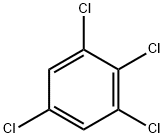1,2,3,5-Tetrachlorobenzene
|
|
1,2,3,5-Tetrachlorobenzene 속성
- 녹는점
- 54.5°C
- 끓는 점
- 246°C
- 밀도
- 1.5578 (estimate)
- 증기압
- 0.07 at 25 °C (extrapolated, Mackay et al., 1982)
- 굴절률
- 1.5348 (estimate)
- 인화점
- 113 °C
- 저장 조건
- APPROX 4°C
- 용해도
- 알코올, 벤젠, 에테르 및 리그로인에 용해됨(Weast, 1986)
- 색상
- 흰색에서 거의 흰색
- 수용성
- 4.016mg/L(25℃)
- BRN
- 1618864
- Henry's Law Constant
- 58.0 at 25 °C (gas stripping-GC, Shiu and Mackay, 1997)
- CAS 데이터베이스
- 634-90-2(CAS DataBase Reference)
안전
- 위험 및 안전 성명
- 위험 및 사전주의 사항 (GHS)
| 위험품 표기 | Xn,T,F | ||
|---|---|---|---|
| 위험 카페고리 넘버 | 22-39/23/24/25-23/24/25-11 | ||
| 안전지침서 | 22-24/25-45-36/37-16-7 | ||
| 유엔번호(UN No.) | UN 1230 3/PG 2 | ||
| WGK 독일 | 3 | ||
| RTECS 번호 | DB9445000 | ||
| HS 번호 | 2903.99.8001 | ||
| 유해 물질 데이터 | 634-90-2(Hazardous Substances Data) | ||
| 독성 | Acute oral LD50 for rats 1,727 mg/kg (quoted, RTECS, 1985). |
1,2,3,5-Tetrachlorobenzene C화학적 특성, 용도, 생산
정의
ChEBI: A tetrachlorobenzene carrying chloro groups at positions 1, 2, 3 and 5.일반 설명
White crystals or off-white solid.공기와 물의 반응
Insoluble in water.반응 프로필
Simple aromatic halogenated organic compounds, such as 1,2,3,5-Tetrachlorobenzene , are very unreactive. Reactivity generally decreases with increased degree of substitution of halogen for hydrogen atoms. Materials in this group may be incompatible with strong oxidizing and reducing agents. Also, they may be incompatible with many amines, nitrides, azo/diazo compounds, alkali metals, and epoxides. 1,2,3,5-Tetrachlorobenzene may react with oxidizers. .건강위험
ACUTE/CHRONIC HAZARDS: 1,2,3,5-Tetrachlorobenzene may cause irritation on contact.화재위험
1,2,3,5-Tetrachlorobenzene is probably combustible.환경귀착
Biological. A mixed culture of soil bacteria or a Pseudomonas sp. transformed 1,2,3,5-tetrachlorobenzene to 2,3,4,6-tetrachlorophenol (Ballschiter and Scholz, 1980). The half-life of 1,2,3,5- tetrachlorobenzene in an anaerobic enrichment culture was 1.8 d (Beurskens et al., 1993).In an enrichment culture derived from a contaminated site in Bayou d’Inde, LA, 1,2,3,5- tetrachlorobenzene underwent reductive dechlorination to 1,2,4- and 1,3,5-trichlorobenzene at relative molar yields of 7 and 93%, respectively. The maximum dechlorination rate, based on the recommended Michaelis-Menten model, was 94 nM/d (Pavlostathis and Prytula, 2000).
Photolytic. Irradiation (λ ≥285 nm) of 1,2,3,5-tetrachlorobenzene (1.1–1.2 mM/L) in an acetonitrile-water mixture containing acetone (0.553 mM/L) as a sensitizer gave the following products (% yield): 1,2,3-trichlorobenzene (5.3), 1,2,4-trichlorobenzene (4.9), 1,3,5-trichlorobenzene (49.3), 1,3-dichlorobenzene (1.8), 2,3,4,4′,5,5′,6-heptachlorobiphenyl (1.41), 2,2′,3,4,4′,6,6′- heptachlorobiphenyl (1.10), 2,2′,3,3′,4,5′,6-heptachlorobiphenyl (4.50), four hexachlorobiphenyls (4.69), one pentachlorobiphenyl (0.64), trichloroacetophenone, 1-(trichlorophenyl)-2-propanone, and (trichlorophenyl)acetonitrile (Choudhry and Hutzinger, 1984). Without acetone, the identified photolysis products (% yield) included 1,2,3-trichlorobenzene (trace), 1,2,4-trichlorobenzene (24.3), 1,3,5-trichlorobenzene (11.7), 1,3-dichlorobenzene (0.5), 1,4-dichlorobenzene (3.3), pentachlorobenzene (1.43), 1,2,3,4-tetrachlorobenzene (5.99), two heptachlorobiphenyls (1.40), two hexachlorobiphenyls (<0.01), and one pentachlorobiphenyl (0.75) (Choudhry and Hutzinger, 1984).
Purification Methods
Crystallise it from EtOH. [Beilstein 5 II 157, 5 III 551, 5 IV 668.]1,2,3,5-Tetrachlorobenzene 준비 용품 및 원자재
원자재
Cyclohexene, 1,2,3,4,5,6-hexachloro-, (3alpha,4beta,5beta,6alpha)-
Cyclohexene, 1,2,3,4,5,6-hexachloro-
1,2,3,4-Tetrachlorobenzene
1-BROMO-2,4,6-TRICHLOROBENZENE
2,4,6-트리클로로페닐히드라진
2,2',4,4',6,6'-HEXACHLOROBIPHENYL
메틸알콜
말론산 디메틸
2,4,6-트라이클로로아닐린
1,3,5-트리클로로벤젠
준비 용품
1,2,3,5-Tetrachlorobenzene 공급 업체
글로벌( 120)공급 업체
| 공급자 | 전화 | 이메일 | 국가 | 제품 수 | 이점 |
|---|---|---|---|---|---|
| career henan chemical co | +86-0371-86658258 |
sales@coreychem.com | China | 29914 | 58 |
| Nanjing Dolon Biotechnology Co.,Ltd. | 18905173768 |
sales@dolonchem.com | CHINA | 2972 | 58 |
| Shanghai Worldyang Chemical Co.,Ltd. | ,+86-21-56795779; +8613651600618 |
sales@worldyachem.com | China | 879 | 58 |
| Xi'an Kono chem co., Ltd., | 029-86107037 13289246953 |
info@konochemical.com | China | 2995 | 58 |
| Hubei xin bonus chemical co. LTD | 86-13657291602 |
linda@hubeijusheng.com | CHINA | 22968 | 58 |
| Chongqing Chemdad Co., Ltd | +86-023-61398051 +8613650506873 |
sales@chemdad.com | China | 39916 | 58 |
| CONIER CHEM AND PHARMA LIMITED | +8618523575427 |
sales@conier.com | China | 49391 | 58 |
| Richest Group Ltd | 18017061086 |
oled@richest-group.com | CHINA | 5601 | 58 |
| Neostar United (Changzhou) Industrial Co., Ltd. | +86-519-519-85557386 |
marketing1@neostarunited.com | China | 8348 | 58 |
| SIMAGCHEM CORP | +86-13806087780 |
sale@simagchem.com | China | 17367 | 58 |








